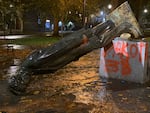
Protesters in Portland toppled multiple statues, including this one of President Abraham Lincoln, on Sunday, Oct. 11, 2020, during an event they called "Indigenous People's Day of Rage."
Sergio Olmos
Last month, the group responsible for managing Portland’s public art collection decided five statues removed or toppled during 2020 protests should not be immediately reinstalled in their original sites.
In the wake of that decision, several more thorny questions have cropped up: Where should these sculptures go? What should replace them? And, finally, how can the city address still-standing monuments that some Portlanders find problematic before protesters take it upon themselves to bring them down?
Commissioner Carmen Rubio announced this week that she plans to let the public decide.
As part of the fall budget process, Rubio is expected to ask her colleagues on the city council for money dedicated to a “community engagement process” that examines what to do with the five statues that were taken down last year. Those include three presidents — George Washington, Abraham Lincoln and Theodore Roosevelt — as well as former Oregonian editor Harvey Scott, who fought women’s suffrage. The other removed statue is a monument of a pioneer family that is titled The Promised Land.
“We believe we need an external partner to support us in this community engagement planning and process that is inclusive of all individuals and communities,” wrote Jillian Schoene, Rubio’s chief of staff, in an emailed statement. “The goals of this process will be to make decisions about the monuments currently in question and also to inform a new public policy should this issue arise again.”
The statues in question had been targeted throughout 2020 as part of Portland’s racial reckoning. The monuments of Lincoln and Roosevelt were torn from their spots on the South Park Blocks during October protests billed as “Indigenous People’s Day of Rage.” Protesters focused on Roosevelt because he had expressed hostility toward Native Americans and Lincoln because he had ordered 38 men executed as part of the war carried out against the Dakota people in 1862. The monument of Washington, who owned slaves, was pulled down on Juneteenth, a holiday commemorating the end of slavery in the United States.
Rubio serves as the city liaison to the Regional Arts & Culture Council, a nonprofit that contracts with both Portland and Multnomah County governments to manage their collections of public art. Rubio’s aides say they’re not clear yet on how much money the commissioner will ask for in this budget cycle nor what shape the engagement process could take.
Heather Nelson Kent, a spokesperson for RACC, said the group envisions the community holding distinct debates for each toppled statue.
“Harvey Scott is not Abe Lincoln,” she said. “These really need to be treated as individual conversations.”
In a letter dated Oct. 15, the board of directors for RACC formally told Rubio that they recommended the five statues should not be automatically put back in their original locations. The decision came after the board had changed its policy this summer so that statues could be removed if the “subject or impact of an artwork is significantly at odds with values of antiracism, equity and inclusion.”
“We believe that this recommendation is consistent with RACC and the City’s commitment to equity and inclusion and action by the Portland City Council recommending new public art representing more diverse cultural identities and histories for the South Park Blocks,” the board wrote. “This recommendation sets into motion the need for a community engagement process to determine next steps for these statues.”
